Foraging for edible mushrooms in the wild is certainly fun and exciting, but if you’re not yet practiced in the fine art of identifying wild fungi, a safer bet is cultivating your own.
Mushroom growing kits allow you to know exactly what you are getting – and this way, you can collect your harvest in your very own kitchen or living room!
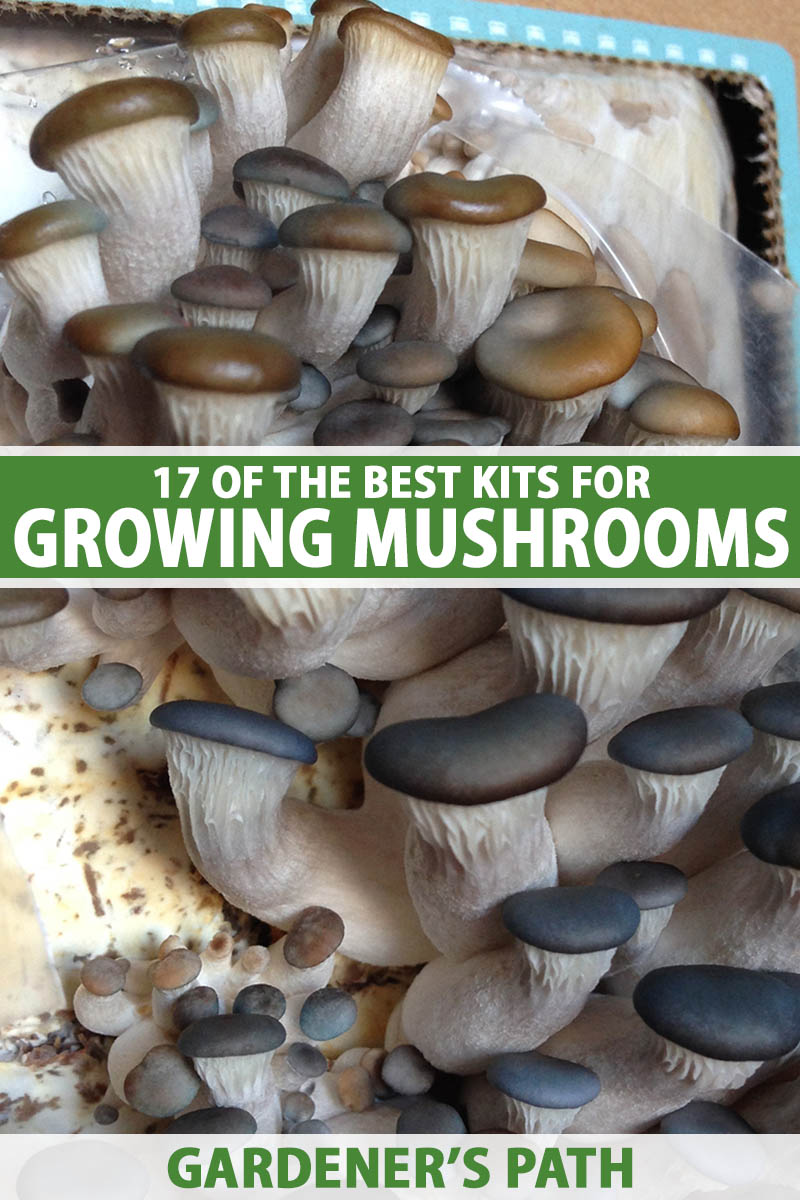
We link to vendors to help you find relevant products. If you buy from one of our links, we may earn a commission.
Mushroom growing kits offer a wonderful way to fulfill your fungi fascination since you can cultivate small amounts in a controlled environment, and choose your favorites as you go.
Plus, cultivating your own edible fungi at home can give you access to types you might not be able to purchase at your local supermarket or farmers market.
Let’s take a look at 17 different options so you can find the perfect kit to tantalize your taste buds, and satisfy your noble desire to produce your own food.
Ready to talk fungi? Let’s go!
17 of the Best Mushroom Growing Kits
Before we start digging into these different kits, let’s go over some basics.
First, you’ll want to select a type of edible fungus that you already enjoy eating or would like to try for the first time. (Note – always sample new fungi in small quantities in case of unexpected allergic reactions.)
If you are a mushroom lover, chances are you already have a few favorites in mind.
Some people love the delicate but pungent flavor of blue oysters, while others love the meatiness of shiitakes. But this is a great opportunity to branch out and try something new as well, such as lion’s mane or pink oysters.

Most mushroom growing kits consist of a fruiting block, which is actually a plastic bag filled with a dense, inoculated substrate.
This substrate is often made primarily of sawdust or grain, though other ingredients such as soy hulls can be used as well.
To get these blocks started, the procedure is usually to cut an “X” in the plastic bag, scrape lightly against the inoculated substrate with a fork, and then begin watering the cut area with a spray bottle.
However, precise instructions can vary from brand to brand, so make sure you refer to the included instructions.
Sometimes a humidity bag is needed as well to cover the block, depending on the species of fungi you select.
These fruiting blocks usually produce one to three harvests, depending on the type of fungi cultivated.
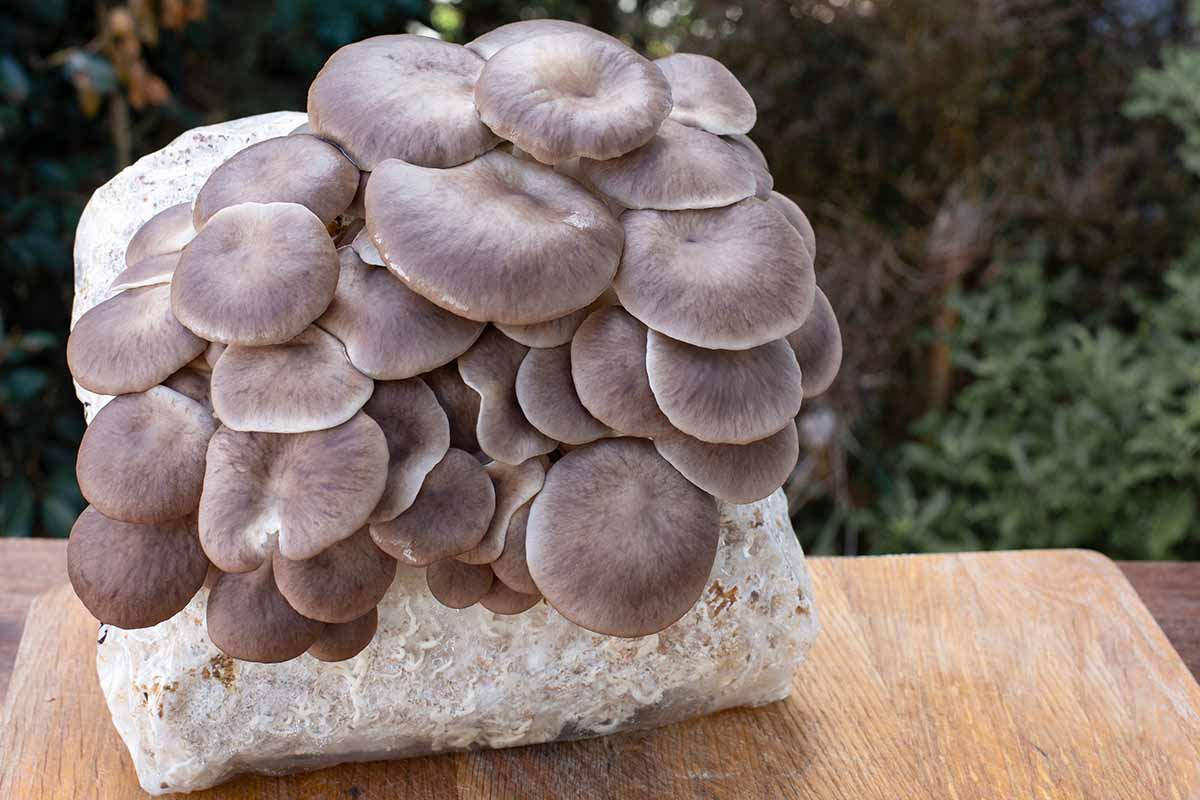
Another type of kit you will encounter consists of inoculated, hand-cut logs. While these are usually used to grow mushrooms cultivated outdoors, they can also be used indoors.
These logs have pre-drilled holes which are filled with fungal spores, or mycelium, and then covered with cheese wax to keep spores from drying out and as a protection from contaminants.
The logs are usually soaked for 24 hours, followed by a chilling period in the fridge which lasts another 24 hours. Then the logs are tented with a plastic humidity bag.
Inoculated logs can last much longer than fruiting blocks – some will produce many crops over the course of three years.
Whichever type you choose, both are very easy to set up and maintain.
All you need to do is to keep them moist and at a relatively consistent temperature during their growing cycle – the kits will come with instructions to guide you through this process.
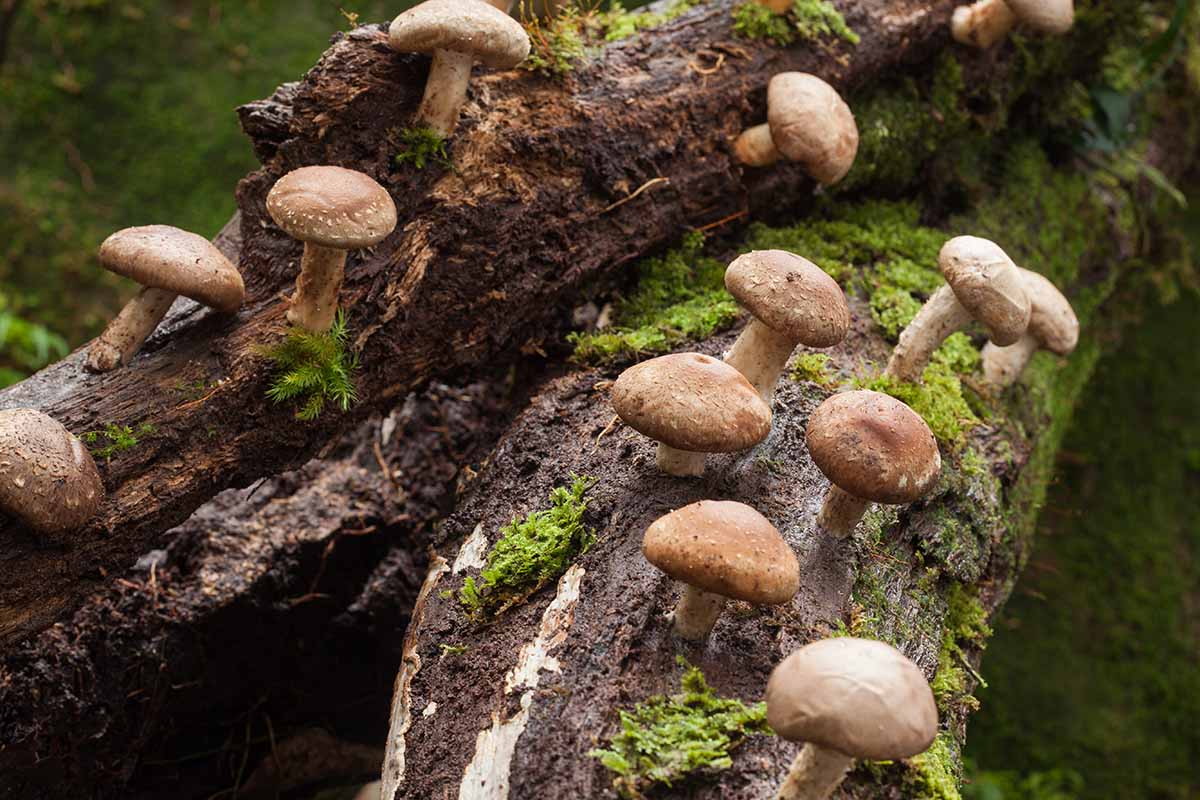
Next, let’s talk a little more about optimum growing conditions.
Most kits are intended for indoor use. For these fungal crops, choose a location in your home that is relatively warm with indirect sunlight exposure, and out of the reach of children and pets.
Ideal indoor temperatures for mushroom growth are typically between 65 and 70°F, but be sure to check the growing requirements for your ‘shroom of choice – some need cool conditions, and others thrive with warmer temperatures.
Also, keep in mind that many types of fungi will grow very slowly in locations that are consistently below 60°F.
Mushrooms also have varying sensitivities to carbon dioxide, so some are cultivated in closed containers, while others require good ventilation.
Specific growing requirements will depend on the species or strain you choose, so be sure to check the package instructions for the varieties that you select.
You should now have a good idea of what to expect when shopping for mushroom growing kits.
But before making your selection, it might also help to acquaint yourself with a few of the terms used by cultivators of edible fungi:
Flush refers to a crop of harvestable mushrooms. After a first crop, many fruiting blocks and logs will produce a second and sometimes even a third flush.
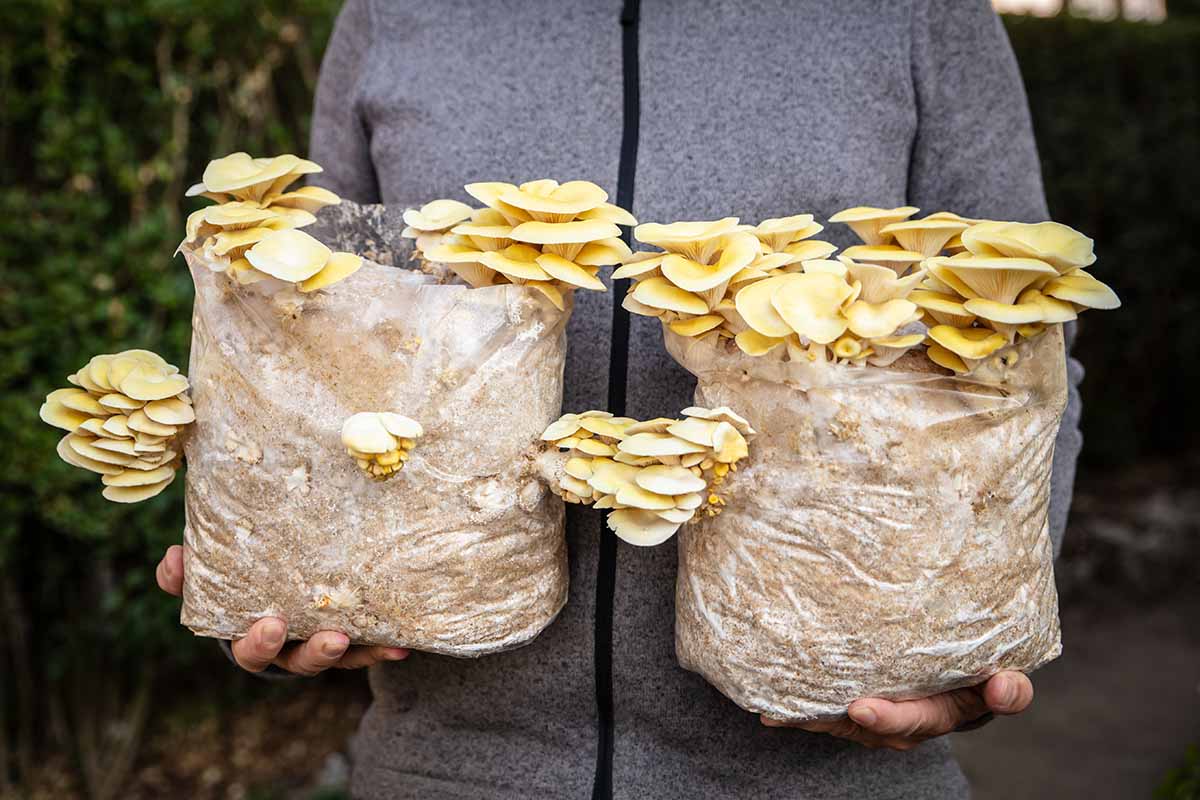
Fruiting is the term used for blocks or logs that are currently producing mushrooms.
Fruiting block is the inoculated block of pasteurized substrate. The substrate is usually made of sawdust or grain, inoculated with mycelium, and contained within a plastic bag.
Mushrooms are the fruiting bodies of some species of fungi. Not all types of fungi produce them. Think of them as something akin to apricots on a tree.
Just like those delicious stone fruits, the mushroom isn’t the whole organism, it’s just the fruiting body. This is the part we are cultivating to indulge our culinary enjoyment.
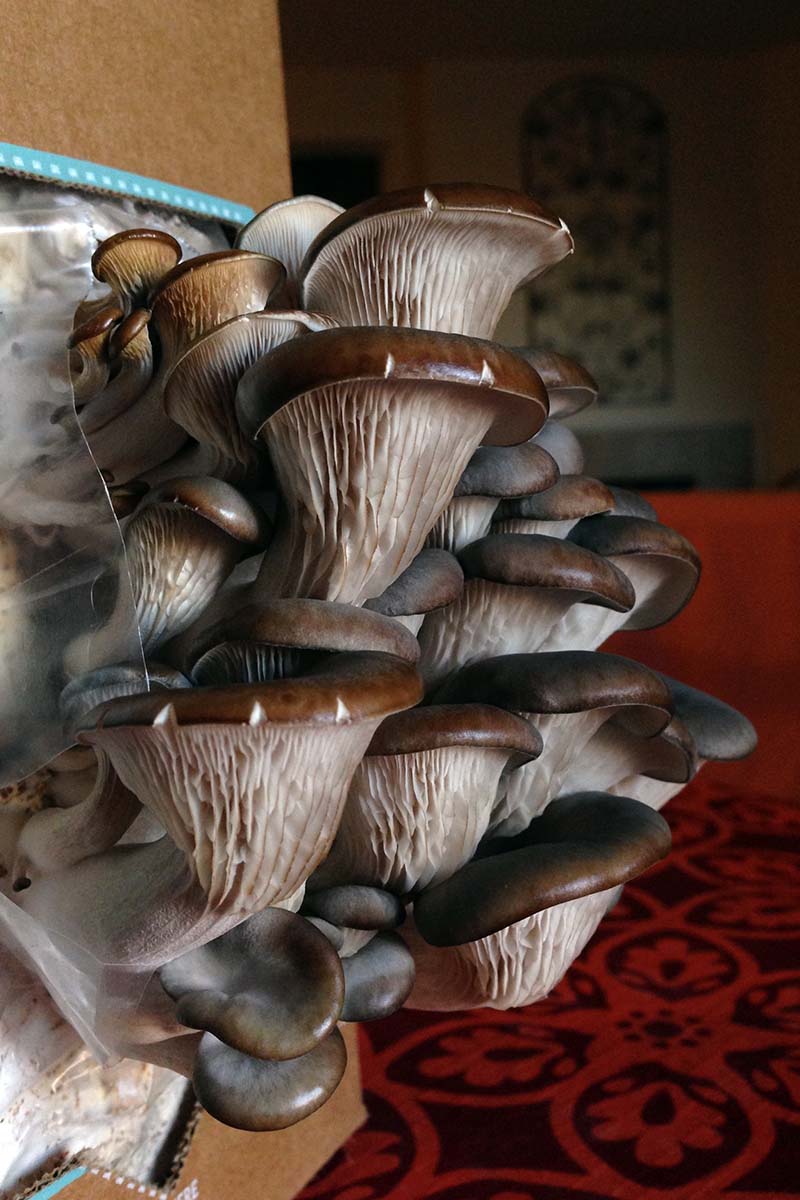
Mycelium are the root-like structures of fungi. Mushroom growing kits come inoculated with mycelium.
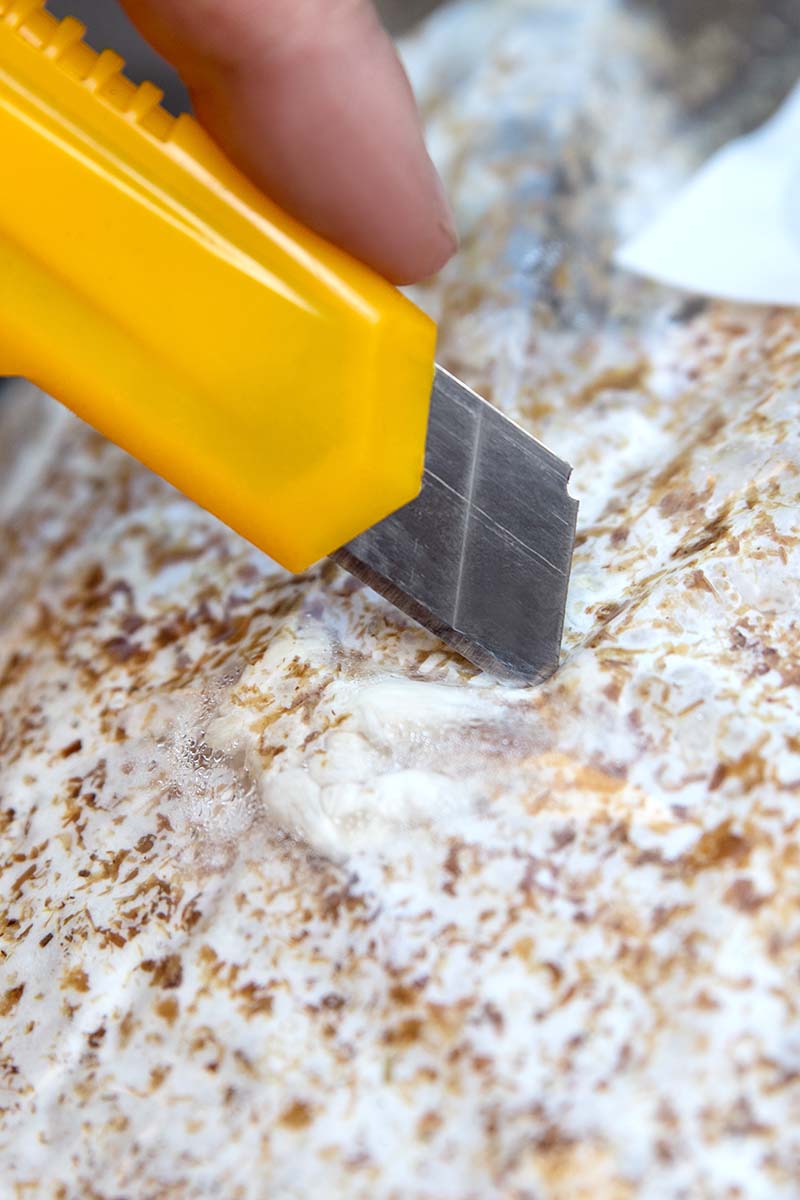
Pinning is what happens when the mycelium begins to form tiny mushrooms, referred to as “pins.” Pinning is the beginning stage of fruiting.
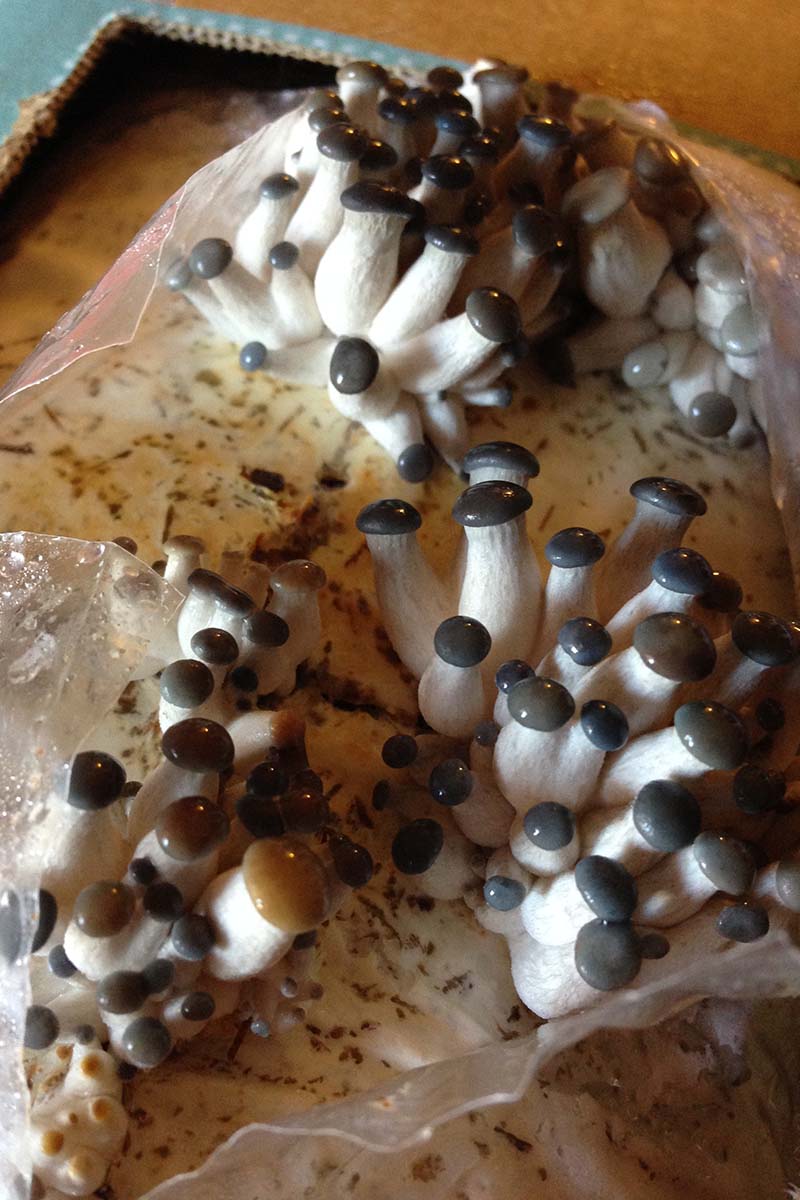
Spawn is a pasteurized substrate inoculated with mycelium.

Now that you’ve got the lingo down, know what to expect from both blocks and logs, and are prepared to read the instructions to provide the right conditions for your crop, you should be ready to peruse this selection of some of our favorite mushroom growing kits!
1. Antler Reishi
This first pick is one you are unlikely to be familiar with, but it may be of interest if you’re keen on the idea of producing your own natural medicines.
Reishi mushrooms (Ganoderma spp.) are fungi used primarily for medicinal purposes.
Their brown and orange fruiting bodies contain antioxidant and bioactive compounds, and can be used to make teas, tinctures, or powdered supplements.
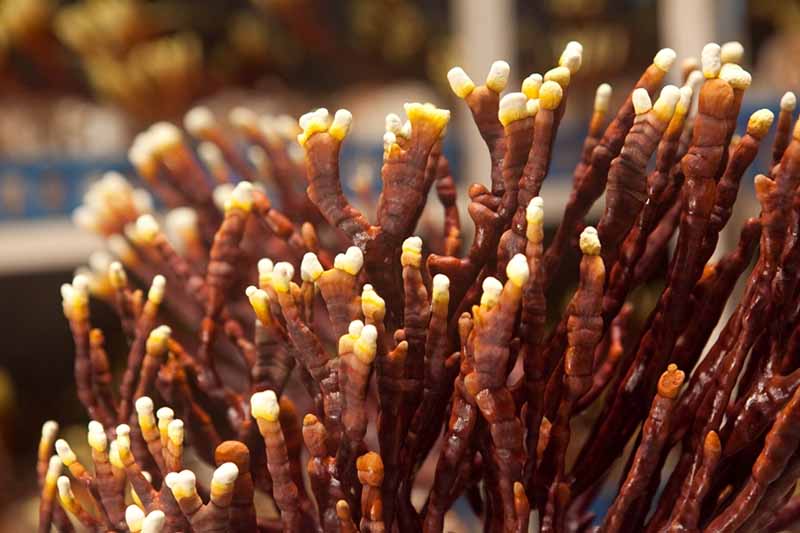
While reishis naturally take on a fan-like shape, when cultivated in closed conditions the buildup of carbon dioxide causes narrow, antler-like fruiting forms to develop rather than fans.
Why bother cultivating them in this way? Antler reishis may exhibit even more powerful medicinal compounds than their fan-shaped counterparts.
Antler reishis have a bitter flavor and a texture much like tree bark, so this is not the type of ‘shroom you’ll want to add to a stir-fry. However, they do make a lovely coffee substitute, providing an earthy, bitter flavor to help start the day.
Root Mushroom Farm offers an antler reishi kit that includes spawn along with a humidity tent, spray bottle, and instructions.

Root Mushroom Farm Antler Reishi Kit
To produce the antler shapes, these fungi require high humidity and carbon dioxide, so they are grown in a closed container.
This beginner-friendly option will start to fruit in approximately 10 days and will produce a single harvest in one to two months.
Ready to add the ability to grow antler reishis to your medicinal plant cultivation skills list?
You can buy antler reishi mushroom growing kits from the Root Mushroom Farm Store via Amazon.
2. Blue Oyster
Looking for a fun fungi staple to grow in your kitchen? Blue oysters (Pleurotus ostreatus var. columbinus) are a great all-purpose culinary mushroom.
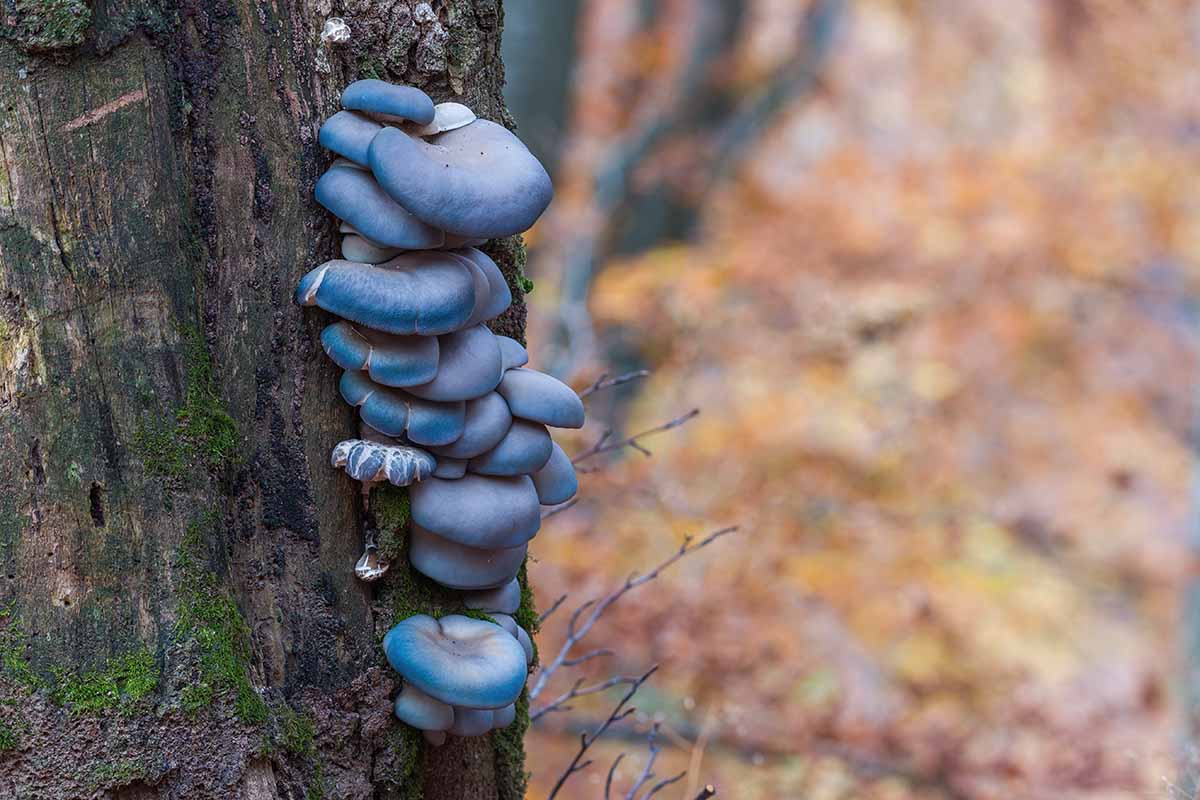
There are many different subspecies, varieties, and strains of P. ostreatus, commonly known as “oyster mushrooms,” and you’ll discover several of them in this roundup. This first selection of Pleurotus comes with a distinctive coloration.
These fungi fruit in clusters of fan-shaped caps that take on a brighter shade of blue when exposed to more sunlight.
These fungi are rich and slightly sweet in flavor. Blue oyster stems are not very tender, so they are usually discarded, but their caps are quite meaty in texture.
For those interested in cultivating these colorful champignons, North Spore provides a certified organic Blue Oyster Spray and Grow Kit.
This option contains a sawdust block colonized with mycelium, a spray bottle, and instructions.
North Spore Blue Oyster Spray and Grow
Blue oysters are very easy to grow and make a great choice for beginners. Fruiting begins within two weeks, with a crop ready to harvest two to five days after that.
A first flush is guaranteed by North Spore, but indoor gardeners should expect multiple flushes from the fruiting block – at least two or three.
You can find North Spore’s certified organic Blue Oyster Mushroom Spray and Grow Kit available for purchase via Terrain.
3. Brown Oyster
For true fungi aficionados, one simply can’t get enough oysters.
Some folks call certain strains of Pleurotus ostreatus “brown oysters” while others reserve that name for another species within the same genus, P. pulmonarius.
Forest Origins offers a brown oyster mushroom growing kit that is a strain of P. pulmonarius known as ‘Sonoma Brown.’
These brown oysters have light brown caps with wavy margins. Cooked, they have a velvety and smooth texture and a meaty flavor.
The Forest Origins kit comes with an inoculated block, a spray mister, and instructions – as well as a second white oyster block!

Forest Origins Brown and White Oyster Kit
Great for beginners, these fungi are ready to harvest in one to two weeks.
Forest Origins guarantees their blocks will fruit at least once, but they should produce a second flush as well.
You can buy this set of Brown and White Oyster Growing Kits from the Forest Origins Store via Amazon.
4. Chestnut
Pleurotus varieties are frequently found for indoor cultivation, but this next type of fungus is harder to source in an indoor growing kit.
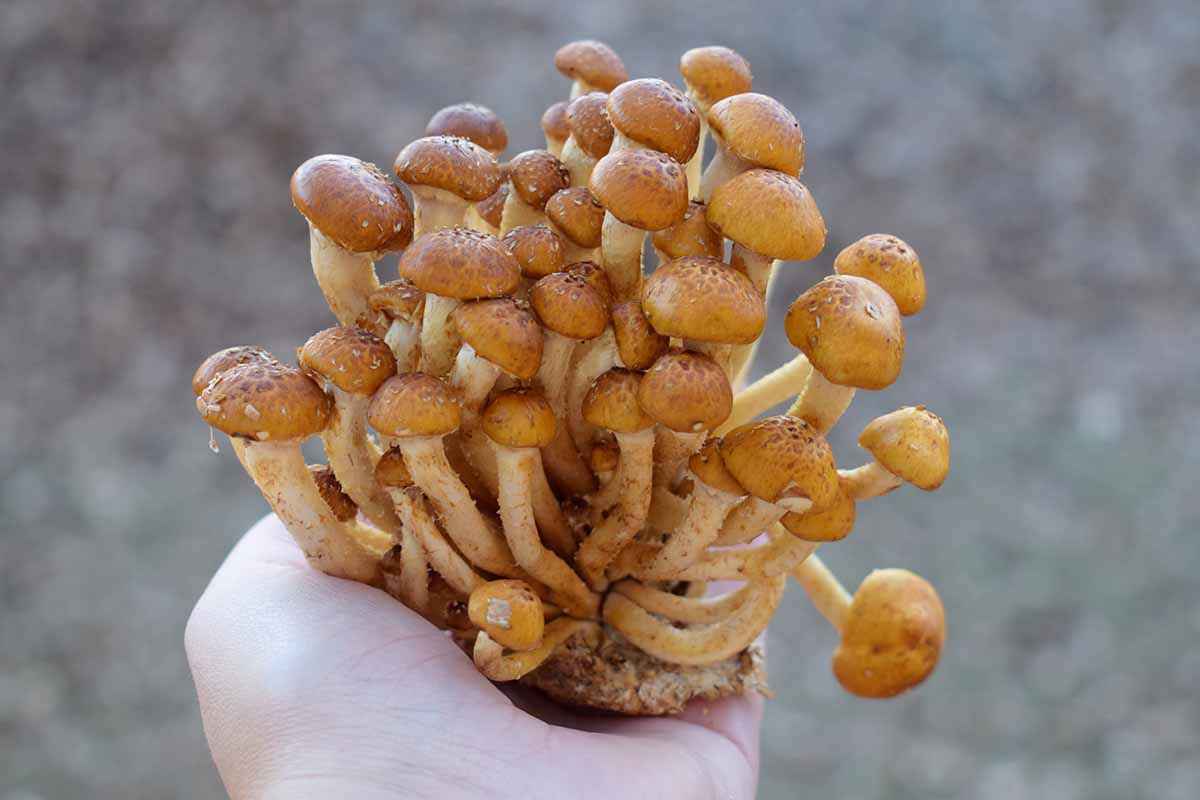
Chestnut mushrooms (Pholiota adiposa) are scrumptious as a culinary ingredient.
Also known as “fat pholiota” or “scaly cap,” these fungi are mild, rich, and nutty in flavor with a peppery aftertaste.
While the caps have a silky texture, the stems have a crunchy bite, similar to steamed asparagus.
Chestnut mushrooms fruit in clusters of toadstool-shaped fruits, whose caps are tan, brown, or brick-red in hue. The caps feature brown scales that are sometimes speckled with white.
Baltispore offers a Chestnut Mushroom Kit that includes an inoculated substrate, a spray bottle, and comprehensive, step-by-step instructions.
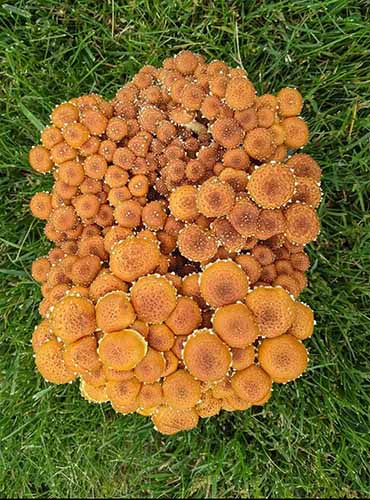
Baltispore Chestnut Mushroom Kit
This option is beginner friendly, and is likely to produce up to two flushes, with the first delicious crop ready to harvest in approximately 10 days.
Guaranteed to produce a first flush, you can buy a Baltispore Chestnut Mushroom Growing Kit via Gardener’s Supply.
5. Cordyceps Militaris
If you’ve cultivated Pleurotus before and are looking for something really unusual to fulfill your fungi fancy, you’ll want to check out this next option.
Also known as “scarlet club mushrooms,” cordyceps (Cordyceps militaris) are dual purpose fungi – they are both tasty to eat and packed with medicinal benefits.
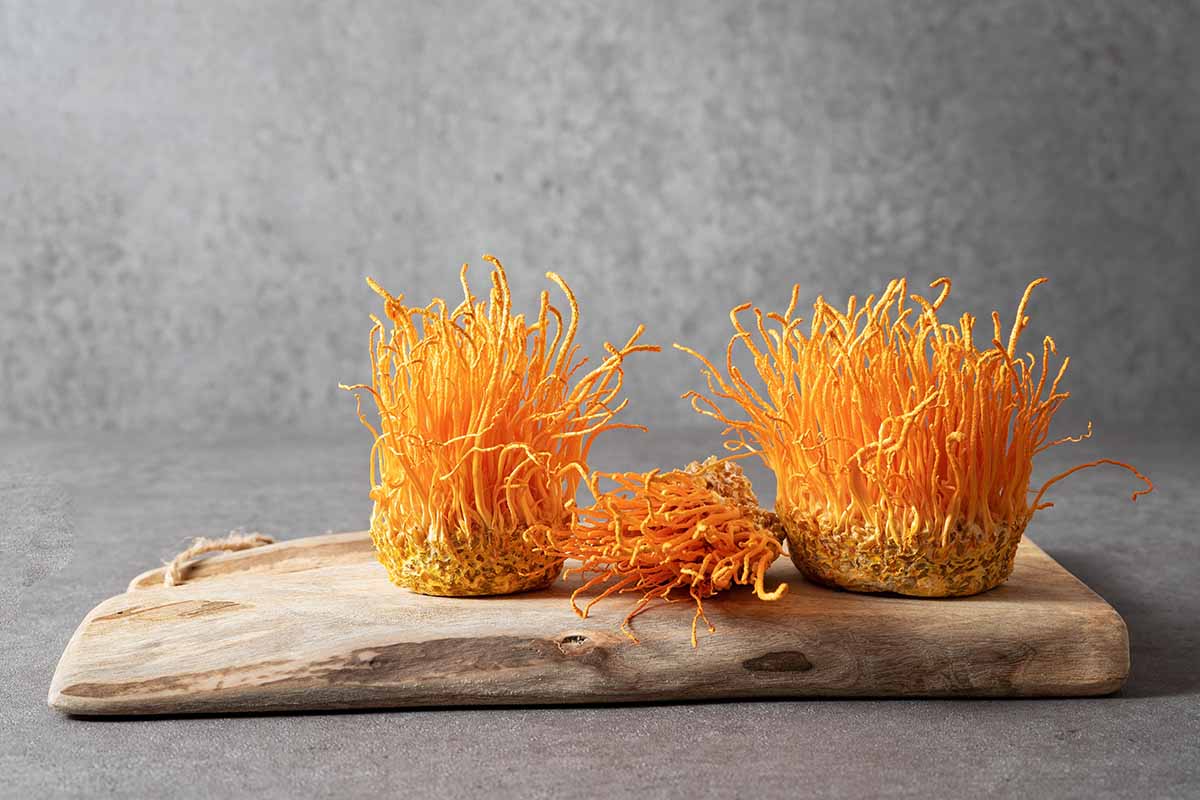
The fruits of cordyceps are long, thin, club-shaped, and orange colored. As a food, these add an earthy, umami flavor to meals, while imparting anti-inflammatory benefits as well as other therapeutic properties.
If you’ve dipped into the fascinating world of mycology before, you may be familiar with these fungi because of the startling fact that they parasitize insects.
This might sound a bit ominous, but when home grown, they can be cultivated on a substrate of grain instead of bugs.
Root Mushroom Farm offers a Cordyceps Militaris Growing Kit. It includes a lidded plastic container with a rice substrate, a syringe for inoculating, and instructions.
This selection is easy enough to use to make it suitable for beginners, and it produces a harvest in 50 to 55 days.
Expect just one flush from this block with fruiting guaranteed by the seller.
You can buy the Cordyceps Militaris Growing Kit from the Root Mushroom Farm Store via Amazon.
6. Golden Oyster
Looking for fungi fit for royalty? Here’s one that would capture the eye of King Midas.
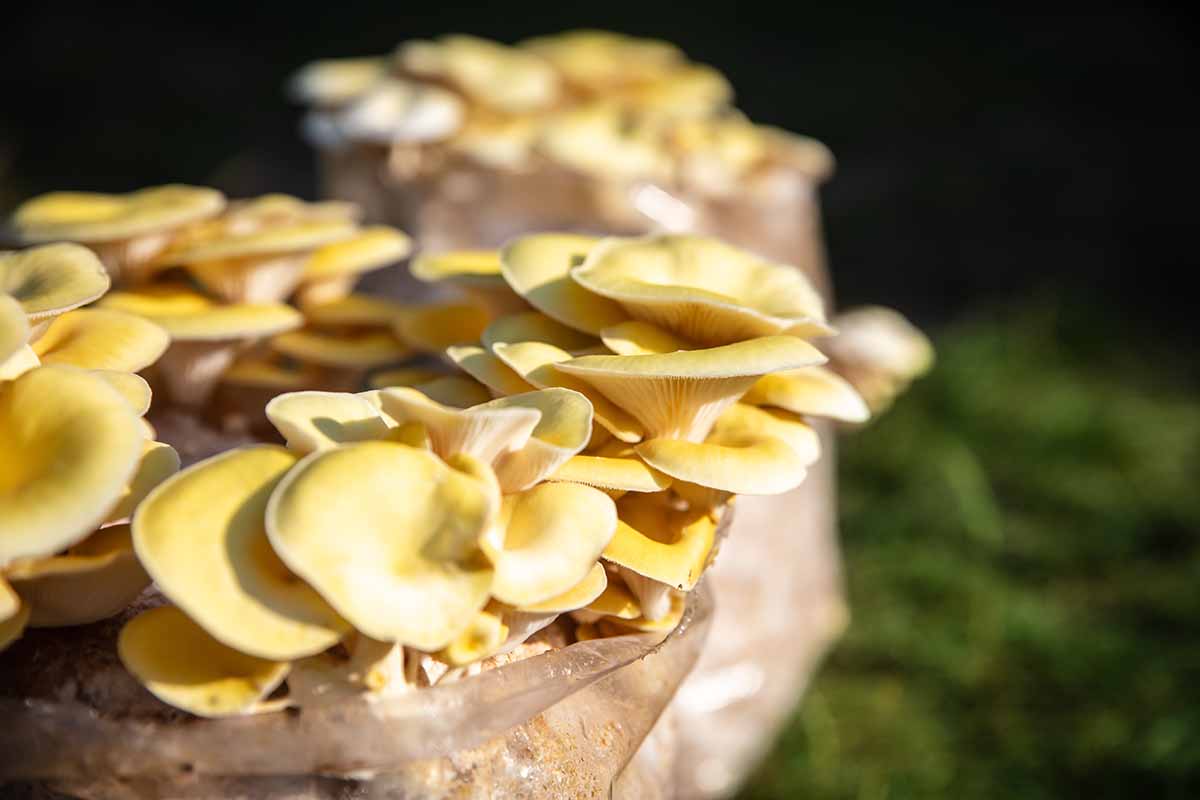
Golden oysters (Pleurotus citrinopileatus) have a delicate, nutty, and sweet flavor, with a chewy, meaty texture.
Also known as “yellow oysters,” these Pleurotus fungi grow in clusters and their caps have a lovely golden to bright yellow hue.
North Spore provides a certified organic Golden Oyster Spray and Grow Kit that includes an inoculated sawdust block, a spray bottle, and complete instructions.
North Spore Golden Oyster Spray and Grow Kit
Cultivating golden oysters is easy for beginners – this block provides a first harvest in two weeks and can easily produce a second flush as well.
Guaranteed to produce, the certified organic North Spore Golden Oyster kit is available via Terrain.
7. King Trumpet
This next selection will herald fungi worthy of a feast.
King trumpets (Pleurotus eryngii) are related to the other oysters we’ve seen here, but these have tan to brown caps and – here’s the big difference – massively thick stems that are tender and succulent when cooked.
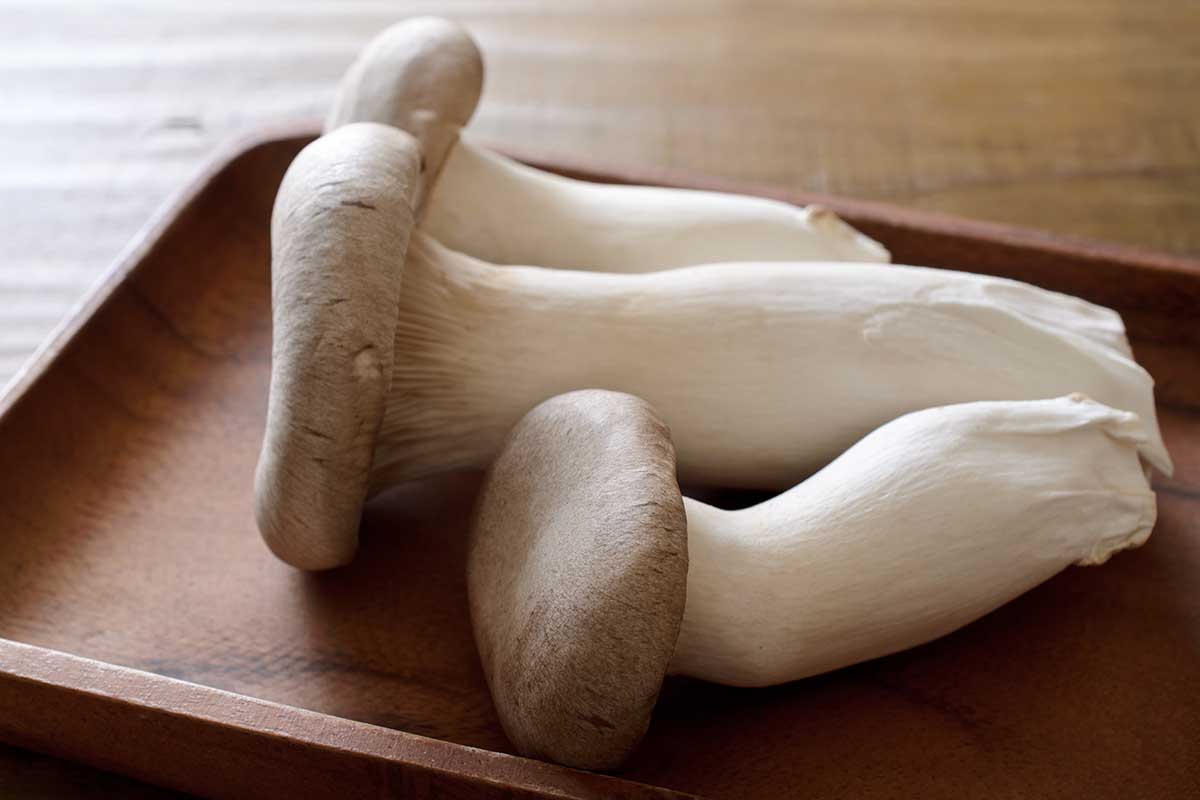
Also called “king oysters,” these fungi have a toothsome, meaty texture, and a flavor that makes a good vegan substitute for crab, lobster, or scallops.
Root Mushroom Farm offers an option to cultivate these ‘shrooms that includes a fruiting block, a humidity tent, a spray bottle, and instructions.
Because these fungi require a cooler than average temperature of 50 to 65°F, these are considered best for intermediate growers.

Root Mushroom Farm King Trumpet Kit
Expect one to two crops from your fruiting block, with the first flush ready to harvest in two to three weeks.
You can buy a King Oyster Trumpet Growing Kit from the Root Mushroom Farm Store via Amazon.
8. Lion’s Mane
Not all edible fungi have the typical toadstool-like cap and stem shape, and lion’s mane (Hericium erinaceus) is one of those outliers.

Also known as “satyr’s beard,” “bearded tooth,” or “pom-pom” mushrooms, this is not your standard button type – these fungi reach baseball or softball size and look like clusters of shaggy puffballs.
Sometimes referred to as “lions mane” without the apostrophe, these funky-looking fungi are tender, with a crab-like flavor and texture.
Baltispore offers a Lion’s Mane Mushroom Grow Kit that comes with a fruiting block, spray bottle, and complete instructions.
Baltispore Lion’s Mane Mushroom Growing Kit
Some consider lion’s mane one of the easiest mushrooms to cultivate, so don’t assume that the unusual appearance of these fungi means they are only for advanced growers!
Expect these blocks to produce a harvest in two weeks.
This selection is guaranteed by Baltispore to produce a first flush. You will likely be able to get a second flush from this block, and maybe a third as well.
You can purchase Lion’s Mane Mushroom Growing Kits from Baltispore via Gardener’s Supply.
9. Pearl Oyster
If you’re new to cultivating edible fungi, you might want to start with a petite package inoculated with a beginner-friendly strain, as is offered in this next selection.
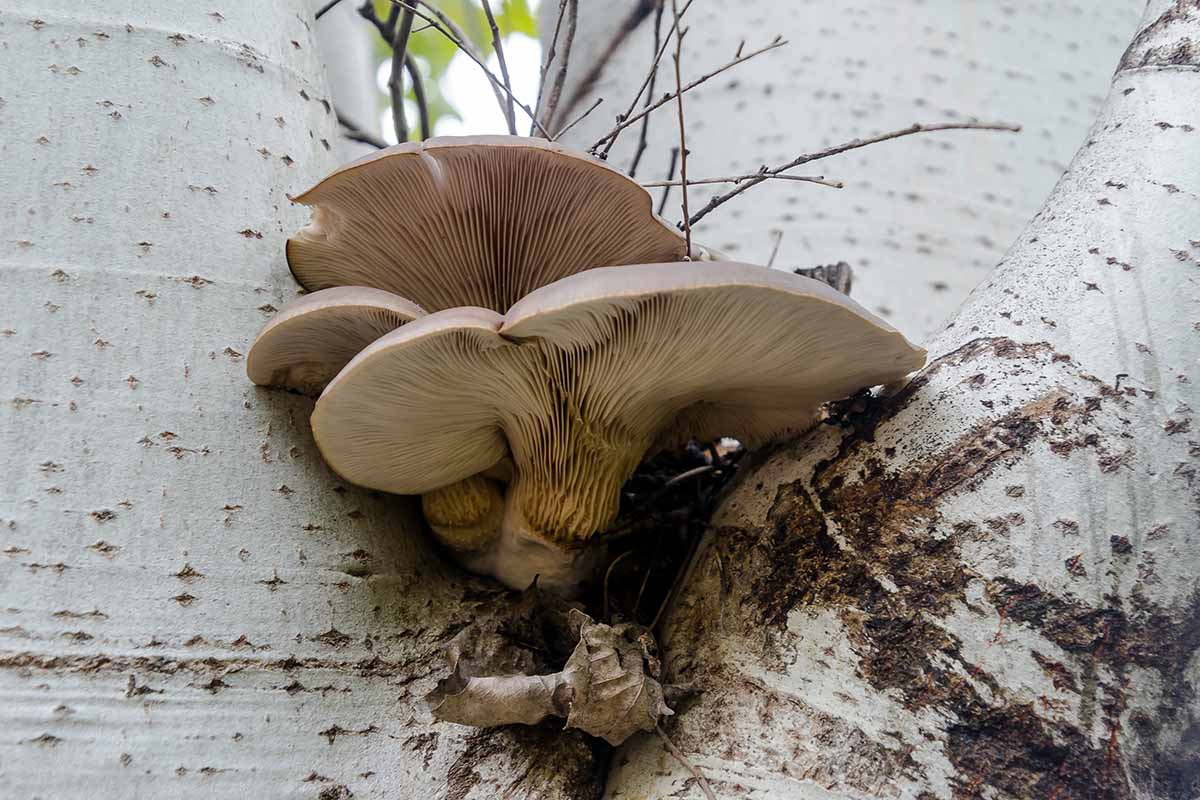
Similar in shape to the other Pleurotus varieties encountered here, pearl oysters, a strain of Pleurotus ostreatus, are produced in clusters of fan-shaped caps and are champagne-colored.
These thick-capped fungi have a slightly sweet, nutty flavor, and a chewy texture.
Back to the Roots offers a pear oyster mini mushroom growing kit. This smaller option, ready to grow out of the box, includes everything you’ll need: the spawn, a spray bottle, and instructions.

Back to the Roots Organic Mini Mushroom Growing Kit
You can expect a harvest of pearl oysters in 10 days.
Back to the Roots selections are beginner-friendly and guaranteed to produce at least one flush, but may produce a second crop as well.
Looking for a smaller option to give fungi cultivation a try? You’ll find this mini mushroom growing kit available from the Back to the Roots Store via Amazon.
10. Phoenix Oyster
While cultivating fungi in spawn bags is the most common way for indoor gardeners to produce Pleurotus indoors, logs are also an option, and you might like to try these logs inoculated with phoenix oyster mycelium.
Phoenix oysters (Pleurotus pulmonarius) have a rich and meaty flavor, and a smooth, velvety texture.

Also known as “Indian oysters,” “Italian oysters,” or “lung oysters,” the caps of these fungi have margins that are either rolled under slightly or rather frilly, giving them a somewhat delicate appearance.
As noted, unlike the other options we have seen so far in our selection, this one produces its fungal crop on a log instead of a block of substrate.
2FunGuys provides a 12-inch inoculated elm log that is plugged with mycelium, and ready to get started. Instructions are also included.
You’ll need to supply your own spray bottle and a plastic bag for tenting.
2FunGuys Phoenix Oyster Mushroom Log
Inoculated logs are longer lasting than substrate blocks, but also a bit slower to get started.
The Phoenix Oyster Mushroom Log can take four to 12 months to produce a first flush, but it can continue to produce crops for three years.
You can buy 2FunGuys’ Phoenix Oyster Mushroom Logs via Terrain.
11. Pink Oyster
If you love all things pink, you can now coordinate your fungi food production with your rose, blush, or mauve decor.
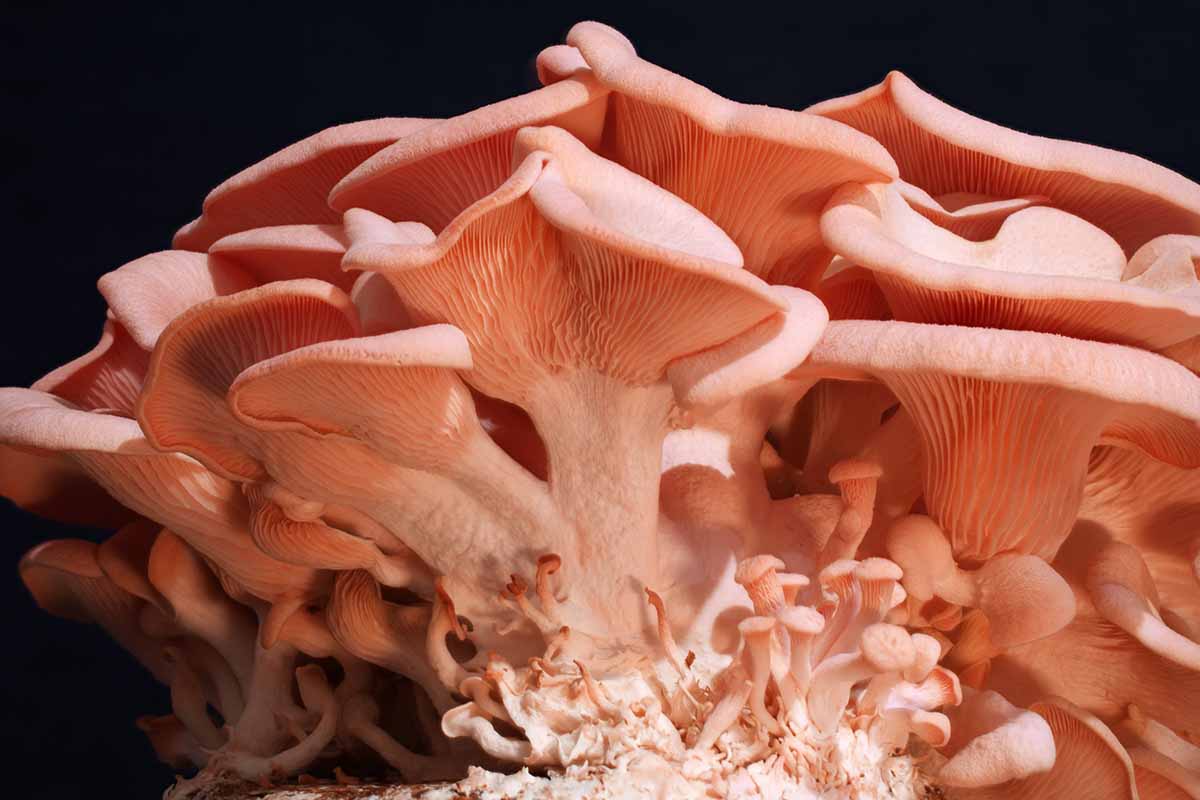
Pink oysters (Pleurotus djamor) have wavy, thin caps and short or non-existent stems – and the real kicker, a gorgeous, pink hue. When cooked, they have a meaty flavor and chewy texture.
Forest Origins claims to be the first company offering pink Pleurotus for sale, and they have done so since 2017.
Their Pink Oyster Kit comes with a fruiting block, spray bottle, and instructions.
These Pleurotus mushrooms prefer warmer conditions between 70 and 80°F, so if you thought your home was too warm during the summer for growing edible fungi, this might be the type to try!

Forest Origins Pink Oyster Mushroom Growing Kit
These are fast to produce, with harvests that are ready in one to two weeks, and they’re great for beginner mycophiles.
Forest Origins guarantees a first crop, but you can expect two flushes from the block.
Get your own Pink Oyster Mushroom Growing Kit from the Forest Origins Store via Amazon.
11. PoHu Oyster
Looking for a large, productive strain to feed your fungi craving? Consider these PoHu™ oysters.
PoHu™ is a strain of Pleurotus ostreatus known for its exceptionally large and prolific clusters of ‘shrooms that are parchment colored. PoHus have velvety, rounded caps that cook up to a delicious tender texture – stems and all! – with a rich, buttery flavor.
Hodgins Harvest sells an Extra Large Oyster Kit that’s inoculated with the PoHu™ strain.
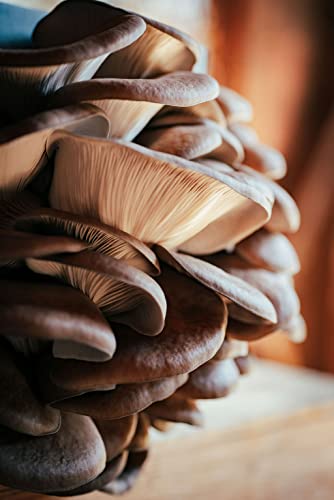
Hodgins Harvest Extra Large Oyster Kit
This selection includes inoculated substrate, a misting bottle, illustrated instructions, and a humidity dome. An instructional video is also available.
This beginner-friendly option is guaranteed to produce a first flush or Hodgins Harvest will replace it for free. However, you can likely expect multiple flushes from this easy to use kit.
Ready to supersize your fungi harvest? Purchase Hodgins Harvest’s Extra Large Oyster Kit from Amazon.
12. Reishi
Curious about using fungi as a functional food? Look no further than reishis.
Known for their immune-boosting properties, reishis (Ganoderma lucidum) have increased in popularity among practitioners of herbal medicine in recent years.
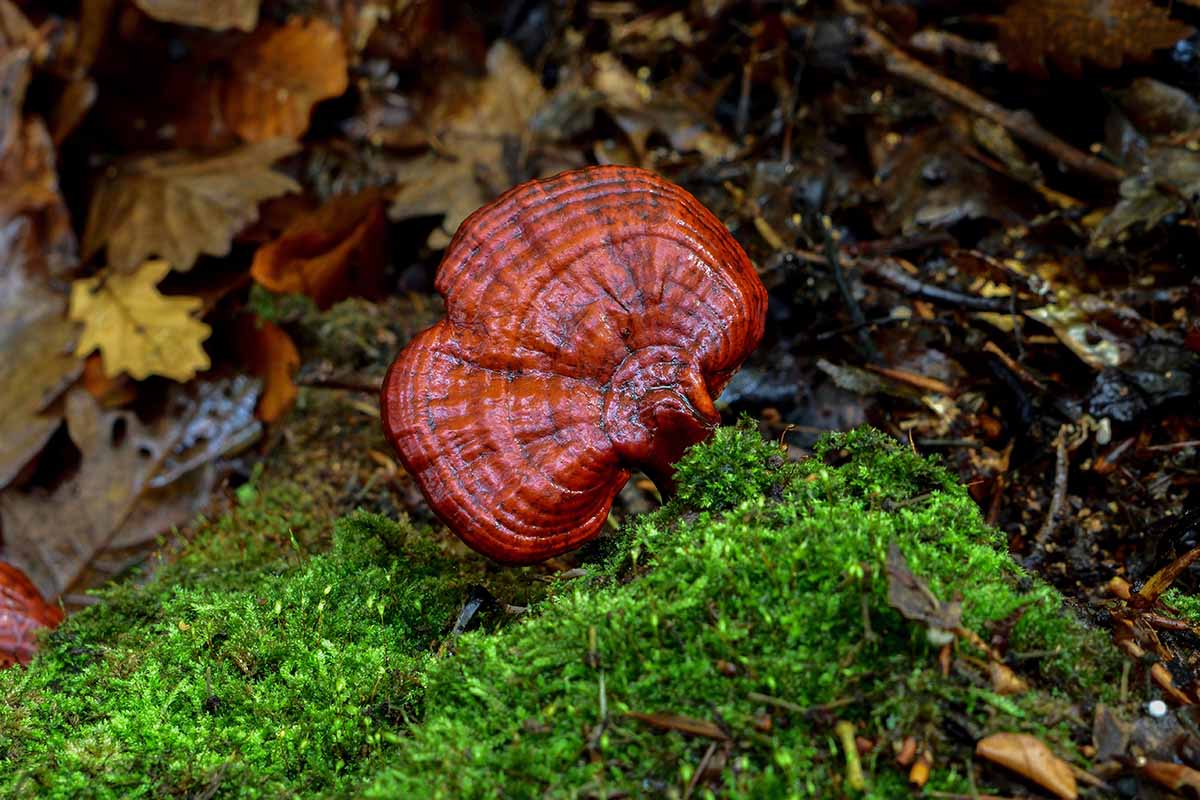
However, far from being newbies to the wellness domain, these fungi – also known as “linghzhi” – have historically been employed in both Japanese and Chinese traditional medicine.
Reishis are red and brown colored, and fruit in a fan-like shape often referred to as “conks.” These conks are tough and corky and have a strong, earthy, bitter taste.
Reishis can be consumed as a tea, powder, or tincture. I find their flavor perfect as a coffee replacement.
Gallboys sells a reishi growing kit that comes complete with instructions, a humidity tent, and inoculated substrate. You’ll need to provide your own mister bottle for watering.

These fungi can be cultivated by beginners, but indoor gardeners should be forewarned that they are slower growing than many of the other options presented here, requiring at least two months to mature to their conk shapes.
Expect a single flush from this block, which is guaranteed to produce a crop.
A reishi option is available from Gallboys Mushroom Kits via Amazon.
14. Shiitake
You may have heard that some gardeners produce tasty shiitake mushrooms in their backyards – but these can also be cultivated indoors!
Shiitakes (Lentinula edodes) are light to dark brown in color with umbrella-shaped caps, and have a delicious, meaty texture and flavor with a hint of smokiness. Their stems can be either tender or fibrous.
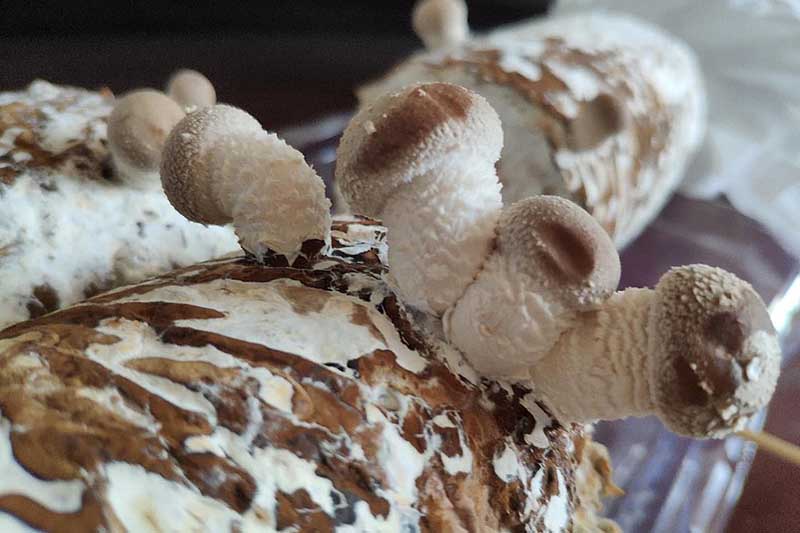
If you want to try this earthy and rich option, 2FunGuys offers pre-inoculated 12-inch logs that are ready to grow, either indoors or outdoors.
Hand-cut logs ranging from three to six inches in diameter are pre-drilled, filled with spores, and sealed with cheese wax so they’re ready to go.
All you need to do is select a location with indirect sunlight where you will place your log either on its side or upright, and follow the included instructions for soaking, chilling, and watering.
With high yields, this type is recommended for intermediate level growers.
And if a 10- to 12-week rest is allowed between each fruiting period, you can expect multiple harvests over the course of three years.
In addition to purchasing the kit, you’ll need to supply a large plastic bag to use as a tent, and your own spray bottle.
2Funguys 12″ Shiitake Mushroom Log
The amount of time required to produce a first flush varies depending on the date when each individual log was inoculated by 2FunGuys.
Logs must be fully colonized with mycelium before they can fruit, which can take four to 12 months. Once pins appear, harvest shiitakes in five to 10 days.
Find 2FunGuys’ 12-inch Shiitake Mushroom Log Kit available for purchase via Terrain.
15. Snow Oyster
So far we’ve encountered types of Pleurotus that are blue, golden, brown, and champagne colored – now here’s one that is snowy white.
A variety of Pleurotus ostreatus, snow oysters have a mild, earthy flavor and a chewy texture.
These fungi have white, umbrella-shaped caps whose shapes hold up well to cooking. They are at their best when cooked until all of the liquid they contain has evaporated.
Melk Carton Kid offers a small snow oyster kit that includes inoculated straw and recycled coffee grounds as a substrate.
Simply open up the box, make a cut in the plastic, soak in water, spray daily, and watch as your edible fungi fruits. It will be ready to harvest in just one to two weeks!
Expect one to two flushes from this beginner-friendly ‘shroom.
Snow oyster kits are available from Melk Carton Kid via Amazon.
16. Turkey Tail
You may be familiar with reishis as a medicinal type of fungi, but have you gotten acquainted with another therapeutic shelf fungus, the turkey tail?
Also known as “cloud mushrooms” and “many-colored polypores,” turkey tails (Trametes versicolor) produce fan-like shelves with wavy margins and multicolored concentric coloration. Colors can include blue, red, green, white, gray, and brown.
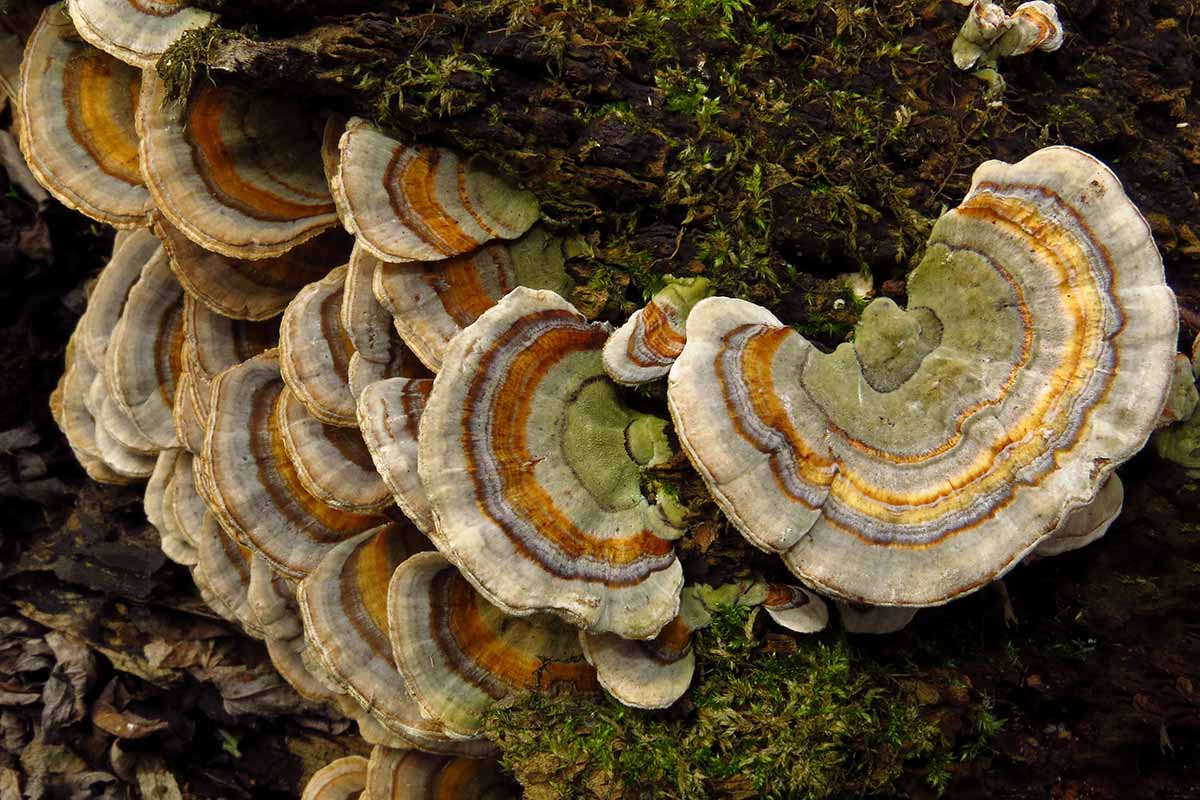
Like reishis, turkey tails are a variety that you may want to cultivate more as a mycological medicine than a food. They possess immune-modulating and anti-cancer properties.
With an earthy, slightly bitter flavor, and a leathery texture, plan to either grind your turkey tails into a powder to use as a functional food or use the conks to prepare your own tinctures or teas.
The Root Mushroom Farm Store has a Turkey Tail Kit that includes a bag of spawn, a spray bottle, a humidity tent, and instructions.
Once you start the block, expect to start harvesting in approximately 10 days. You may get up to three flushes total from the fruiting block.

You can buy your own Turkey Tail Kit from the Root Mushroom Farm Store via Amazon.
17. 3-Pack Bundle
When faced with so many excellent picks, it may be hard to choose just one option. In this case, why not choose to grow the rainbow?

3-Pack Bundle of North Spore Kits
This bundle from North Spore offers a colorful spectrum of options – blue, golden, and pink oysters.
Ready to purchase this three-pack of North Spore certified organic Spray and Grow Mushroom Kits? You’ll find it at Amazon.
It’s Alive!
Nothing could be better than harvesting your favorite variety of edible fungus nice and fresh, minutes before dinner is served.
That flavor will linger on your tongue and in your mind long after your meal is over.

We hope you’ll enjoy selecting and cultivating the perfect mushroom growing kit.
When you’ve made your choice, let us know about it in the comments section below. And if you have any great fungi-focused recipes, feel free to share them with our readers as well!
Looking for more inspiration for indoor gardening projects? You’ll find more reading right here:

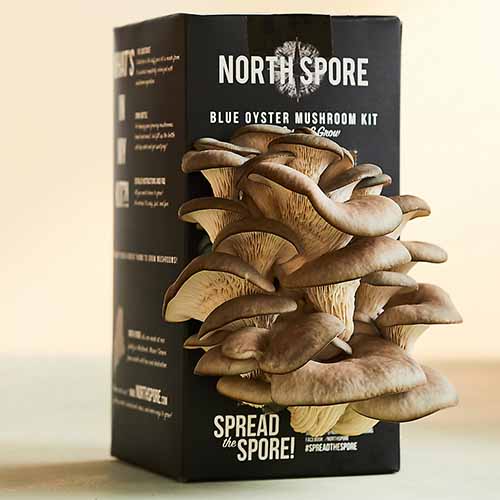
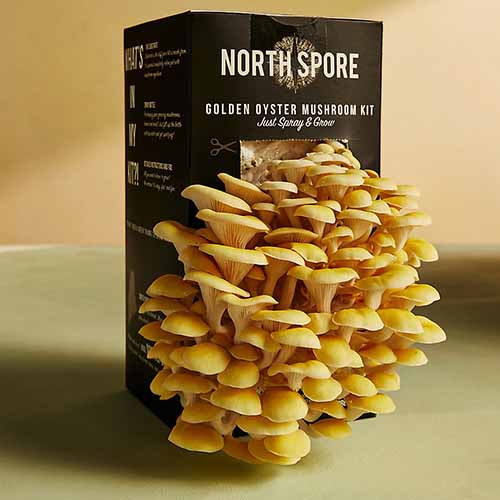
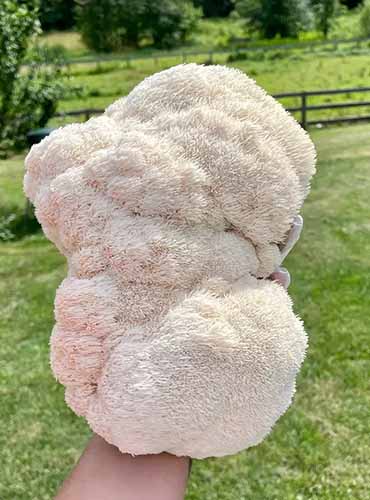

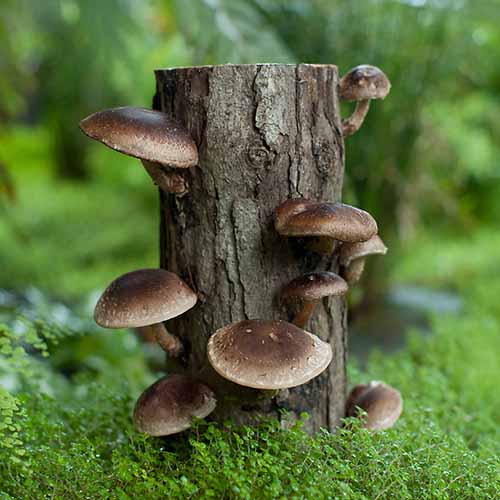
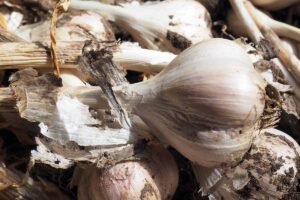
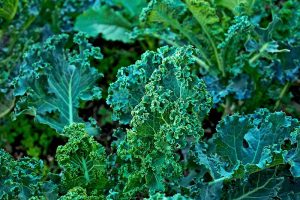

Love your site. Want to grow my own mushrooms so bad.
Good Day!
Josie K, Minnesota, USA
Thank you for taking the time to write this clear, concise and informative page on mushroom kits. I appreciate it very much! Happy gardening to you, when the weather finally arrives for this most pleasurable engagement. The light, the geese and other birds presently flying overhead say it is just around the corner. Yay!
Very well written.
Thanks for writing this! I am not personally a fan of mushrooms, but my roommate loves them. I want to give him a grow-your-own kit for Xmas. Since I don’t know much about mushrooms I needed this info to find the right kit. Thanks so much!
I was living in NH where I had Black Trumpet and Maitake. Just moved to South Central Florida, a tropical climate. How do I find out what mushrooms are best here? I have lots of shade and moist soil but it’s pretty warm. Thank you!
Being a transplant from the Mid-Atlantic to a more southern climate myself, I can relate! Chanterelles are one type that’s known for doing well in Florida. Todd F. Elliott and Steven L. Stephenson’s field guide Mushrooms of the Southeast should help to point you in the right direction with some additional suggestions. And if you’re planning to grow mushrooms in your new climate outdoors, check out our article for some additional tips!
Cherokee Purple are my favorite Heirloom tomato, I’m excited about growing fungi! We have a 30+ year Tomato nursery in Tulsa,Oklahoma ( the Tomato Mans Daughter) check it out!!! Best Heirloom Genetics
I want to grow my own mushrooms.
Trying one of these kits is a great way to start! ????????????
🙂
Can I grow Morels in a greenhouse? If not, what kind do you recommend? Thanks
Hi Jodie,
You can grow morels in a greenhouse setting if you can keep the greenhouse at the right temperature – or if you are flexible about when you undertake this project.
Morels do best when the soil temp is 55-59°F, so this may be a better spring or fall project for most USDA growing zones.
Most mushrooms don’t fruit in temperatures over 80°F.
If you are interested in an alternative however, Pink Oysters will keep fruiting up to 85°F.
Hope this helps!
No you cannot grow morels in a green house. In fact YOU CANNOT Grow morels at all. No one in the history of mankind has figured out how to grow morels. This is a scam.
Though liquid mycelium growing of certain types of mushrooms requires sterile lab conditions that would be extremely difficult to replicate at home, companies like Gourmet Mushrooms do actually sell kits that contain living morels in a block of spawn, and these have proven to be a successful mode of outdoor home cultivation in suitable conditions. You are correct, however, that these are meant for outdoor growing, rather than greenhouse cultivation. Mycology expert Paul Stamets at Fungi Perfecti discusses successful morel cultivation in this video. By taking a culture of the new mushrooms that grew and comparing that with the original… Read more »
What will happen if my grow kit starts to have mould????
What does the mold look like? This isn’t an uncommon problem, since mushrooms do best in a humid environment. Most kits come with a pre-sterilized growing medium to help get your edible fungi off to a good start. But even so, contaminated water or air in the growing area can cause issues. Did your kit come with any troubleshooting instructions, or customer service contact information? I recommend contacting the company that made the kid for advice. If you notice green mold, some growers recommend sprinkling a bit of salt on it to see if that solves the problem. If… Read more »